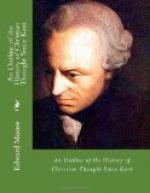A devoted pupil, writing immediately after Ritschl’s death, used concerning Schleiermacher a phrase which we may transfer to Ritschl himself. ’One wonders whether such a theology ever existed as a connected whole, except in the mind of its originator. Neither by those about him, nor by those after him, has it been reproduced in its entirety or free from glaring contradictions.’ It was not free from contradictions in Ritschl’s own mind. His pupils divided his inheritance among them. Each appropriated that which accorded with his own way of looking at things and viewed the remainder as something which might be left out of the account. It is long since one could properly speak of a Ritschlian school. It will be long until we shall cease to reckon with a Ritschlian influence. He did yeoman service in breaking down the high Lutheran confessionalism which had been the order of the day. In his recognition of the excesses of the Tuebingen school all would now agree. In his feeling against mere sentimentalities of piety many sympathise. In his emphasis upon the ethical and practical, in his urgency upon the actual problem of a man’s vocation in the world, he meets in striking manner the temper of our age. In his emphasis upon the social factor in religion, he represents a popular phase of thought. With all of this, it is strange to find a man of so much learning who had so little sympathy with the comparative study of religions, who was such a dogmatist on behalf of his own inadequate notion of revelation, the logical effect of whose teaching concerning the Church would be the revival of an institutionalism and externalism such as Protestantism has hardly known.
Since Schleiermacher the German theologians had made the problem of the person of Christ the centre of discussion. In the same period the problem of the person of Christ had been the central point of debate in America. Here, as there, all the other points arranged themselves about this one. The new movement which went out from Ritschl took as its centre the work of Christ in redemption. This is obvious from the very title of Ritschl’s great book, Die Christliche Lehre von der Rechtfertigung und Versoehnung. Of this work the first edition of the third and significant volume was published in 1874. Before that time the formal treatises on theology had followed a traditional order of topics. It had been assumed as self-evident that one should speak of a person before one talked of his work. It did not occur to the theologians that in the case of the divine person, at all events, we can securely say that we know something as to his work. Much concerning his person must remain a mystery to us, exactly because he is divine. Our safest course, therefore, would be to infer the unknown qualities of his person from the known traits of his work. Certainly this would be true as to the work of God in nature. This was not the way, however, in which the minds of theologians worked. The habit of dealing with conceptions as if they were facts had too deep hold upon them. So long as men believed in revelation as giving them, not primarily God and the transcendental world itself, but information about God and the transcendental, they naturally held that they knew as much of the persons of God and Christ as of their works.




